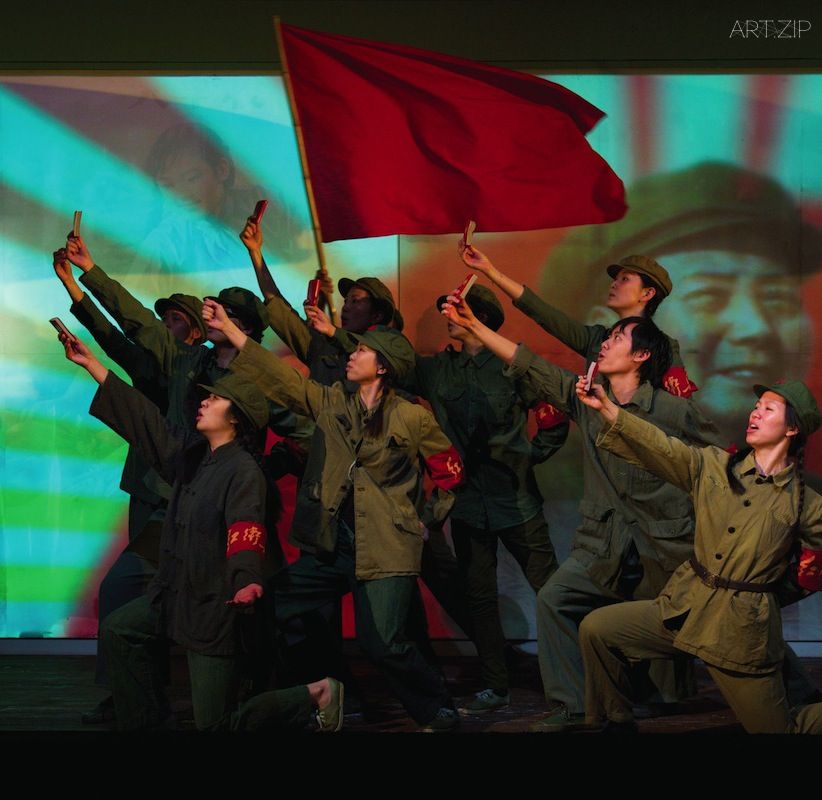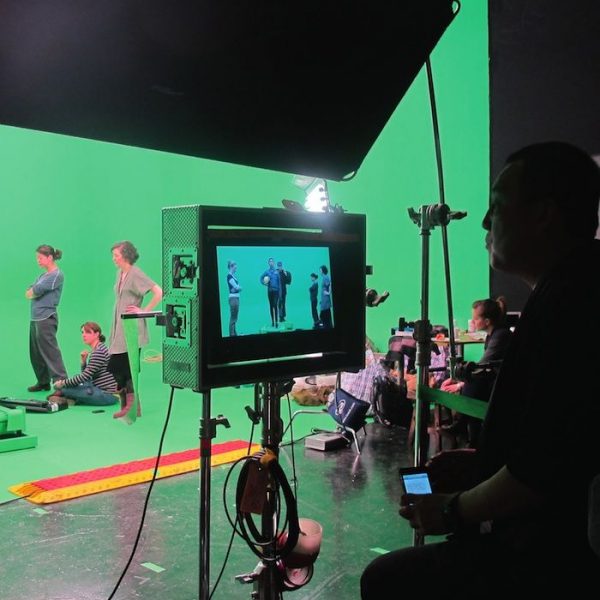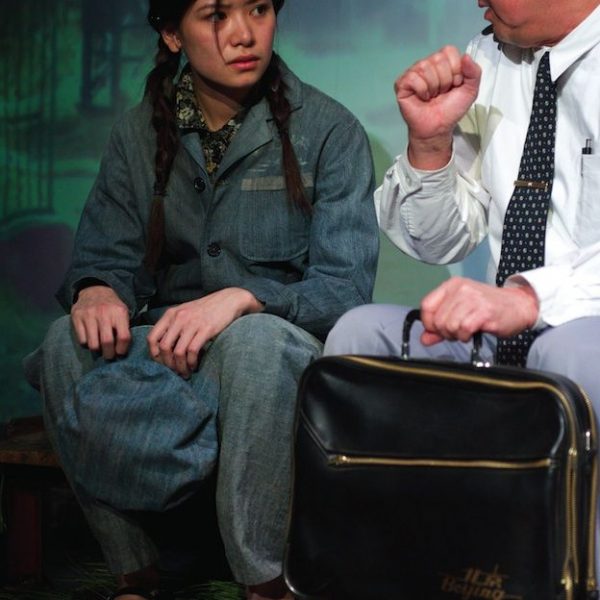
ART.Zip: When you sit in the auditorium watching Wild Swans, how do you find this play from an audience’s point of view? And how about your part of creation for the play?
Wang: I felt very interesting indeed. For the production work, I just participated in part of the process, while as an audience, I experienced the whole process, from the beginning till the end of the show with other audience. I did not merely pay attention to my own creation itself, but the entire play as a whole. In the past, I could just watch a play only for one time, and did not have the patience to watch it again. But for this play, even though I have watched the rehearsals and the shows for many times, I am still not fed up with it yet. It is probably because I have been involved in this production. I am willing to watch it again and again. Many people are quite curious about this. To be honest, I am indeed obsessed with this play. There is always something new, beside the part I produced, surprises me when I watch it again and again.
ART.Zip: 當您坐在劇場中,觀看《野天鵝》這 部舞臺劇時作為觀眾的您對於這部戲是怎樣的 感受? 對於您自己的影像創作部分又是怎樣的 感 受?
Wang:這個感受挺有意思的,當你創作的時候 你是從一個比較局部的角度來參與,當最後這 個劇上演的時候它變為了一個整體,當你和觀 眾一起從入場到結束,變成了不單單是關注自 己創作的影像那一部分,而是整個影像對整個 劇的作用。不知是不是因為我參與了這個劇的 創作,以前經常去看舞臺劇,不過很多戲看過了就不會有耐心再看一邊。可是這個戲,從開始 到排練到結束我看了好多遍了,說句真誠的話, 真的是看了還願意再看,好多人也問我這個事 情,這個劇還是真的每次看的時候都能找到吸 引我的東西,不僅僅是我做的那部分。
ART.Zip: Your artworks are often presented in galleries or similar public spaces. But for this time, it is in the theatre with specific timing and story telling. does it have any impact on you?
Wang: From this production, I find theatre focus more on narration and sequence, the story narration in particular, to express emotions. In this case, the visuals follow to lay more weight on depicting the time and the story. This is the way how I applied visuals for this play with the purpose to develop the story and context. This production experience makes me realize the difference between visual art creation and theatre production. There are more functionalities and focuses when creating visual art. But it is not necessary to practise all the elements on my artworks. If it is for my own practice, I would prefer to pick the main focused elements of visual art, which are different from those of theatre, such as high-resolution visual images and colours.
ART.Zip: 您的藝術作品常常呈現在畫廊或者公 共空間,但此次在劇場空間裡的呈現,同時還 具有典型的時間性和敘事性。這樣一次創作方 式對於您的個人創作有什麼啟發嗎?
Wang: 通過參與劇場這種表現形式,更能體 會到戲劇更注重敘事性和時間性,來傳達一種 情感,或者通過故事,特別是故事情節,所以影 像在這個劇更多的是偏重來描述一種時間性 和敘事性。我在這個劇採用的方式都是配合和 描述劇情的發展和語境。作為我個人的創作上 來講,這個劇讓我更認識到影像藝術與戲劇的 不同,影像藝術會有更多的功能和不同的關注 點,但我不一定會將這些功能帶入我的作品,我 自己的作品上可能會選擇更拉開影像藝術和戲 劇表達方式上的這些不同,比如高清影像的形 象,色彩這些可能有別於戲劇關注點的方面。
ART.Zip: Is there any difference between the relationships of theatre-to-audience and gallery-to-viewers?
Wang: It could be quite a very specific but at the same very abstract answer, as it is related to two kinds of art forms and the ways how audience and viewers experience these two arts. Simply to say, audience enter the theatre expecting to experience in a full story from the beginning till the end within specific timing. On the other hand, people go to a gallery not to be required to enter there in any specific time, nor do they look for any whole story narration. If viewers are not interested in some visual artworks in the gallery, they can choose to walk away.
However, once audience buy tickets for a show and sit in the theatre, no matter if they pay any interests in the story or not, but due to moral respects, they would stay there until the end. These are the fundamental differences between the two relationships.
It is also the essential reason that I took this collaboration opportunity, not just to find out the differences between these two art forms and the relationships of them with their audience and viewers, but to question these existing differences which are worth bearing in mind: why stories have to be narrated from the beginning till the end; why theatre has to be presented in limited dark places; and why the artworks in the galleries could not convey the messages through full story telling?
ART.Zip: 在劇場中觀眾與作品的面對面,與在 畫廊裡觀眾與作品的面對面有什麼不同?
Wang: 這個問題很具體又很大,牽扯到兩種 藝術方式及受眾群觀看方式的不同,簡單上來 說,戲劇是在一個時間段內觀眾有充足思想準 備的進入到一個故事當中去,從頭到尾的欣賞 一個完整的情節,而畫廊裡面對時間上的強制 性不強,任何人任何時間都可以走進畫廊看到 影像作品,所以在畫廊裡的影像作品強調敘事 和時間性對觀眾來說意義不大,因為觀眾走進 畫廊心理上的準備是來欣賞一件藝術作品而不 是來從頭到尾聽一個故事。
影像作品在畫廊裡,觀眾看兩眼覺得很難進 入,很難理解,可能不喜歡,然後轉臉就會走, 甚至有的都不會走近觀看,但是戲劇不同,觀 眾買了票,坐在劇場裡,不管喜不喜歡,基本上 還是尊重一個社會規則就是要把它看完,這可 以是說最表面的一個不同。
這也是我願意參與這個跨界和這個劇創作的 一個本質出發點,不能說影像藝術與戲劇有觀 看方式的不同就有所不同,而是對一種既有規 則和習慣的質疑,為什麼故事就一定要從頭講到尾?為什麼戲劇一定要在黑屋子裡上呈現?或者說為什麼畫廊裡的 藝術作品就不能通過一個故事來傳達觀念?我覺得這種質疑的態度應 該存在。




